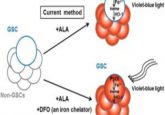GPS: directing cancer treatment by evaluating tumor cell malignancy

This GPS isn’t going to help you find your way, but it could one day evaluate the malignancy of brain tumor cells in patients, informing treatment plans.
Being able to evaluate tumor malignancy is a key step in deciding which cancer therapy is most appropriate for the patient. However, existing methods for this evaluation are invasive and carry a high risk of complications. Researchers at Hokkaido University (Sapporo, Japan) have developed a non-invasive malignancy evaluation method, the cancer grade probing system (GPS), which utilizes a non-destructive europium complex for the continuous detection of brain tumors and their malignancy grades.
The team tested their GPS method on model glioma cells. Glioma is an aggressive and common type of tumor in the brain, accounting for 26.3% of brain cancers. Having the ability to determine the malignancy grade of this kind of tumor in a noninvasive way could lead to quicker and more tailored interventions.
 Works like a CHARM: the AI model that genomically profiles gliomas
Works like a CHARM: the AI model that genomically profiles gliomas
AI can genomically profile brain tumors during surgery, offering real-time guidance on how best to remove or treat glioma.
GPS works by using a non-destructive, water-soluble, luminescent europium complex. The team achieved this by first modifying the europium complex to be water soluble and stable when introduced to the cell culture media. The europium aggregates before interacting with tumor cells, at which point the aggregates separate into single molecules that can be taken up by the tumor cells. This process causes structural changes in the europium complex, altering its red-light emission.
GPS was introduced to three model glioma cell cultures, each mimicking a different degree of malignancy. The researchers were able to measure and view changes in the europium’s red-light emission using a spectrofluorometer and confocal microscopy, respectively; within the first 3 hours of adding europium, the team observed that the more malignant cells displayed larger changes in light emission than the less malignant cells.
The red-light emission differences observed between tumor cells of varying malignancies have been attributed to the tumor activity and growth processes of those cells, which could affect the structure of the europium complex at different times. Although further research is needed to validate this method for use in humans, this GPS method could allow for the continuous detection of brain tumor activity, informing both the treatment course and allow for monitoring throughout treatment.


